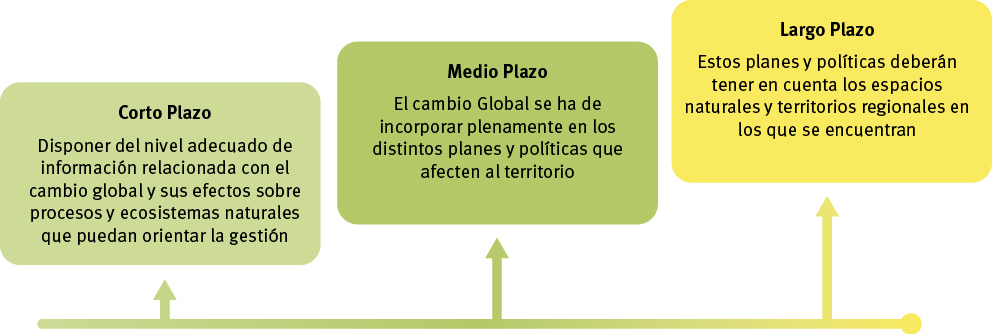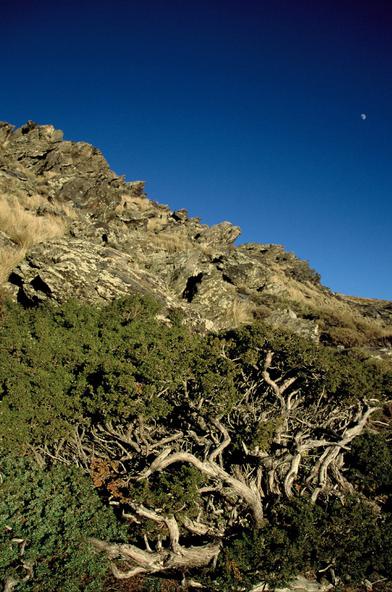Introduction
Given the magnitude of the challenge we face and the significant level of uncertainty that exists regarding the possible evolution and consequences of the changes that are occurring on earth, it is essential to be able to perform a real-time detection and evaluation of complex alterations, and understand its operation, as well as the interaction of some processes with others, their possible synergies, attenuations and, ultimately, the effects they will have as a whole.
The management must be able to anticipate these phenomena, facilitating the adaptation of living organisms. It is not, therefore, to conserve our ecosystems in a static way, but to promote a dynamic conservation of their functions and processes that help them adapt to the changes they are already experiencing. This is what is understood today as active and adaptive management
Adaptation is understood as a series of adjustments in practices, processes and structures, in response to or anticipating changes in environmental conditions. Within this adjustment process we include three concepts:
- Active adaptive management and evaluation of strategies.
- Integration of climate change threats in conservation plans.
- Planning in Protected Natural Areas considering disaster mitigation factors.
The adjustment process translates into objectives in different time horizons:
- Short term: Have the appropriate level of information related to global change and its effects on natural processes and ecosystems that can guide management.
- Medium term: Global change must be fully incorporated into the different plans and policies that affect the territory.
- Long term: These plans and policies should consider not only natural areas, but also those regional territories in which they are located, and that are permeable to the movement of native species, and fundamental in terms of their role as ecological corridors.

Actions to achieve these objectives
The actions to achieve these objectives can be grouped into five categories:
- Awareness raising of managers, local inhabitants and society in general that visits the Protected Natural Area.
- Predicar con el ejemplo:
- Reducing greenhouse emissions
- Adapting the regional climate change strategy
- Introducing adaptations to climate change in park management plans, etc.
- Active ecosystem management:
- Eliminate or mitigate non-climatic threats in situ
- Use adaptive flexible approach management
- Use the results obtained from research on climate change
- Adjust the limits of protected areas as the requirements of the species in process of adaptation vary.
- Research:
- Understand the past and future impacts of climate change
- Identify values at risk of being significantly impacted
- Support climate models adapted to the terrain.
- Monitoring
- Promote protected areas as integrated long-term management places.
- Collect information, make it available to society and share the conclusions.
Examples
Adaptive management of Quercus pyrenaica masses in Sierra Nevada to global change processes
The Sierra Nevada oak groves constitute a set of forest masses distributed within the mountain range at medium levels (between 1,000 and 2,000 meters of altitude). All of them are in the southernmost limit of the natural distribution range of the species and are subject to changing pressures in recent times, mainly associated with a greater water deficit. All this is manifested in an extension of the dry period, which coincides with the vegetative period of the species with lower water reserves in the soil. All this contributes to a general weakening of the masses with the consequent loss of reproductive capacity, subjecting them to a greater predisposition to attacks by harmful agents (mainly defoliation pests).

Conservation and improvement of the common juniper and shrublands masses in Sierra Nevada: Adaptation to global change processes.
The common juniper and shrublands of Sierra Nevada constitute characteristic vegetable formations of the oromediterranean floor. They form rich and evolved plant structures known as juniper-broom-shrublands or mountain scrub. It is the habitat of numerous species of vertebrate and invertebrate fauna, being fully adapted to snow and ice during much of the year. Both formations have suffered a decrease in their territorial distribution and a greater presence in the community of low-range or target species. Given this situation, the manager's response is to introduce new elements that allow the mass group to obtain the necessary resources for a future in those places where it is foreseeable that they can survive within the coming climate scenario, even accepting the fact that these masses will disappear from some places and will give way to another plant structure, other forms and another landscape.

Both projects are based on a common generic hypothesis: Both plant formations are currently in a situation of stagnation, and even degradation, motivated by a changing and largely unknown environmental conditions.
In them, a direct application of the criteria and measures of active and adaptive management has been carried out. They incorporate a dynamic and forward-looking vision, directly inferring processes and negative signals that have been detected, and which have been working from the field of applied research.
The adaptive management model that has been followed in both projects introduces both a set of new elements in its conception. Among these, stands out the flexible approach and the direct incorporation of applied field research. Some of the elements considered in the approaches and drafting of the projects are:
- Use of facilitating species for sowing or planting. Basically spiny species that protect young seedlings from herbivory, in addition to protecting them from sunstroke and subtracting evaporation, increasing the water available in the soil.
- Use of indirect tools:
- Puesta en servicio de acequias tradicionales y protección de surgencias naturales de agua. En ambas formaciones (robledales y enebrales-sabinares) existe una relación directa entre su presencia y condiciones favorables de cierta de humedad edáfica.
- Localización y selección de enclaves de dónde se dan unas condiciones óptimas actuales y previsiblemente futuras (requerimientos de humedad, insolación suelo) para la existencia de esas formaciones vegetales. Sólo en estos lugares se planifican actuaciones de siembra o plantación.
- Eliminación de especies ocupantes y oportunistas que no ejercen efecto facilitador sobre las especies seleccionadas y que ocupan, por deterioro o por efecto de la acción antrópica, estos lugares óptimos seleccionados.
- Protección en primeras etapas de desarrollo frente a la herbivoría silvestre y doméstica eliminando este factor natural con objeto de garantizar un asentamiento inicial completo de los rodales de nueva implantación.
- Utilización en las plantaciones y siembras de especies acompañantes que producen una mejora sustancial del hábitat y una garantía adicional de supervivencia de las comunidades.
- Utilización de la metodología denominada núcleos de dispersión, consistente en crear enclaves que en un futuro próximo van a funcionar como elementos dispersantes de semillas.
Todos estos elementos son incorporados y tenidos en cuenta en la redacción de los proyectos de ejecución. El seguimiento de las actuaciones puede inferir cambios y modificaciones que deberán asumirse por el gestor, pues la retroalimentación continua prevista en el proceso de gestión adaptativa permite incorporar nuevos cambios y resultados de la investigación a la gestión.